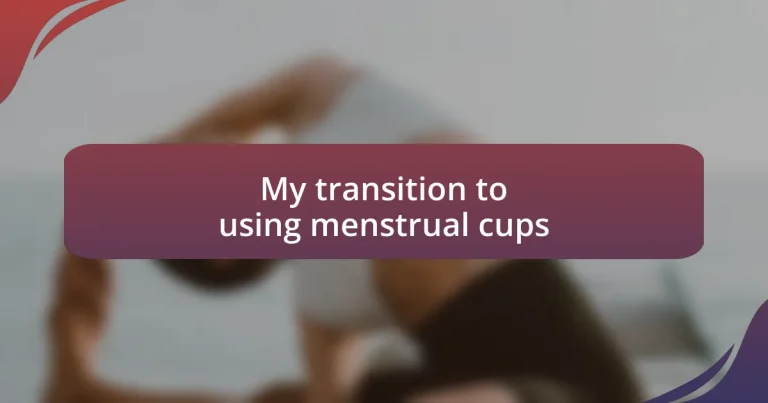Key takeaways:
- Menstrual cups are eco-friendly, reusable alternatives to pads and tampons, offering both comfort and reduced menstrual waste.
- Benefits include significant cost savings, longer wear time (up to 12 hours), less odor, and increased body awareness.
- Choosing the right cup involves considering size, material, and firmness, tailored to individual needs for a better experience.
- Proper care includes sterilizing the cup after cycles, storing it in a breathable container, and being mindful of one’s body during use.

Understanding menstrual cups
Menstrual cups are reusable, flexible funnels made of medical-grade silicone, rubber, or latex. When I first learned about them, I was intrigued but also intimidated. Would it really be comfortable? The idea of inserting something inside me felt foreign, but I soon discovered that comfort was part of the journey.
Using a menstrual cup can drastically reduce menstrual waste, which is a huge plus for those environmentally conscious, like me. I remember the first time I used it; I was surprised at how little disruption it caused to my day. Have you ever found yourself annoyed by the constant need to change pads or tampons? I certainly have, and I found that the cup offered not just convenience but a sense of freedom I hadn’t anticipated.
It’s fascinating how menstrual cups can hold more fluid than traditional options. For many, it means fewer changes needed throughout the day, which was a game changer for me. I remember venturing out on a long hike for the first time with my cup, feeling secure and empowered. Isn’t it incredible how something so small can bring about such a profound shift in our comfort and confidence during our periods?

Benefits of using menstrual cups
Switching to menstrual cups has opened my eyes to a range of benefits that I couldn’t have anticipated. For starters, the financial savings are significant. When I calculated how much I used to spend on disposable products, I was shocked. Menstrual cups can last for years with proper care, which means fewer trips to the store and more money in my pocket for things that matter to me.
Some key benefits of using menstrual cups include:
– Eco-Friendly: They drastically cut down on landfill waste compared to pads and tampons.
– Comfortable: Once I got the hang of it, I forgot it was even there.
– Longer Wear Time: I can wear my cup for up to 12 hours without worry, allowing me to have uninterrupted activities.
– Less Odor: The design keeps menstrual fluid contained and doesn’t expose it to air, often resulting in less unpleasant smell.
– Body Awareness: Using a cup honed my understanding of my cycle, as I became more in tune with my body and flow.
Embracing this change felt empowering. The first time I went swimming while on my period was liberating—no worries about leaks or discomfort, just pure enjoyment splashing in the water. It’s a small step that has brought me enormous peace of mind.

Choosing the right menstrual cup
Choosing the right menstrual cup can feel overwhelming given the myriad options available. It’s essential to consider factors such as size, firmness, and capacity. During my transition, I learned the hard way that not all cups are created equal; what worked for one friend didn’t quite fit my needs.
Sizing is particularly important, as menstrual cups come in different sizes typically categorized by flow and whether you’ve given birth. I remember my first experience with an incorrectly sized cup—it was uncomfortable and made me second-guess my decision. Researching and finding the right fit made a significant difference.
Another aspect to contemplate is material. Some cups are made of medical-grade silicone, while others use rubber or TPE (thermoplastic elastomer). Since I have sensitive skin, I gravitate towards the soft silicone options. Choosing the right cup not only improves comfort but also impacts your overall experience, leading to a much more enjoyable and confidence-building journey.
| Criteria | Examples |
|---|---|
| Size | Small, Regular, Large |
| Material | Medical-grade silicone, Rubber, TPE |
| Firmness | Soft, Medium, Firm |
| Capacity | Regular, Heavy flow |

Tips for successful transition
Getting comfortable with inserting and removing the menstrual cup can take a little practice. I vividly remember the anxiety I felt on my first try, worrying if I’d do it wrong. One tip that worked wonders for me was to practice during my lighter flow days; it allowed me to get used to the motions without the added pressure. Have you ever struggled with something new and felt nervous about getting it right? That’s completely normal!
Another crucial tip is to use plenty of water-based lubricant. On my journey, I discovered that a little lubricant made the whole process smoother—literally. Finding the right technique was part of my learning curve, but once I started using lubricant, it transformed my experience. A friend once mentioned it feels more like a dance than a task, which I totally agree with!
Don’t forget the importance of a relaxed mindset. I noticed that when I approached the cup with anxiety, it rarely went smoothly. Taking a few deep breaths and giving myself a moment to ease into it made all the difference. Have you ever found that your mindset can change your experience? For me, staying calm helped me embrace this new routine, turning a daunting task into an empowering moment.

Caring for your menstrual cup
Caring for your menstrual cup is surprisingly simple, but it does require attention to detail. After each cycle, I make it a habit to sterilize my cup by boiling it in water for about five to ten minutes. This step not only ensures it’s free from bacteria but also gives me peace of mind knowing I’m starting fresh for the next month. Have you ever felt that satisfaction of knowing you’ve taken care of your health?
Storage is another critical aspect to consider. I learned the hard way that keeping the cup in an airtight container isn’t the best idea—it can promote moisture buildup. Instead, I use a breathable cotton bag. This way, my cup stays dry, and I feel confident it won’t become a breeding ground for unwanted bacteria. Simple changes like this can make such a huge difference, don’t you think?
Finally, always listen to your body when it comes to usage and care. I remember a time when I noticed an unusual odor after using my cup, prompting me to reevaluate my cleaning routine. It’s essential to recognize when something feels off and adjust accordingly. Maintaining a mindful approach to how my body interacts with the cup has been a game changer, making the process feel more intuitive and less mechanical.


